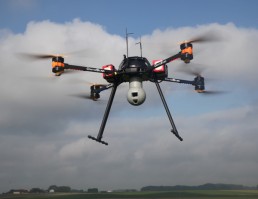When it comes to drone performance, most of the attention is naturally focused on the hardware specs. But what’s often overlooked – and equally important – is the software inside the drone. As with any technology, drone performance is dependent on how everything works together inside.
The hardware does the heavy lifting
The brain of the drone is a tiny piece of silicon called an SoC (system on a chip). Chipset makers such as Intel, Qualcomm, and Ambarella all have specialized flight SoCs for drones. These SoCs typically have a multi-core processor with support for flight control systems, gyroscope, altimeter, Global Navigation Satellite System (GNSS), Bluetooth, Wi-Fi, and 4K video processing, amongst other technologies.
Commercial drones in particular are equipped with multiple sensors and ultra HD cameras generating a lot of critical data. For example, drones used for agriculture may have IR (infrared) sensors to detect plant health, while those used for mapping may have LIDAR (light detection and ranging) surveying technology on board.
Hard-working software to match
Until the past few years, drones relied on either proprietary operating systems (OSes) or Arduino-based controllers. Today, more and more drones are running Linux-based software. On top of the OS are various drivers providing support for all the various sensors and technologies. Microsoft exFAT by Tuxera and Microsoft FAT by Tuxera file system software are two such embedded drivers. These file system software technologies bring support for SD cards used to store recorded image and sensor data on select drones available now and coming soon to the market.
But our software does more than just read and write data to the SD card – it gets more performance out of the hardware inside drones. Here are five ways how:
1. Ultra-reliable SD card support
Drones can crash for a variety of reasons such as pilot error, hardware failure, or freak accidents. With alternative file system software, you can’t be sure the recorded data is saved to the SD card and readable after the crash. But Tuxera’s software is fail-safe, meaning you can count on retrieving your data, even if the drone is severely damaged.
2. Longer SD card lifetime
Writing data on the SD card wears it out. Because our software writes data so efficiently to the SD card, it causes less wear – which means a longer lifetime.
3. More battery power for flight
Our software writes and stores data more efficiently than other file system software – meaning less CPU usage, less battery drain, and more juice for flight!
4. Fast data transfer speeds
Today’s drones are used for increasingly complex applications requiring more processing power than ever. Our software uses advanced proprietary algorithms and data structures to ensure maximum data transfer speeds (known as I/O throughput).
5. Better video performance
Drones need lightning-fast software to reliably write large, HD video files. When recording to an SD card, there’s a short delay between what’s happening in front of the camera and writing that video data to the card. This phenomenon is called “write latency.” During 2K or 4K recording, the video data is sent to the card at high speeds. But with latency factored in, frames can get dropped during the write process. Tuxera’s file systems are designed to counteract this phenomenon and prevent frame loss during intensive ultra-HD video recording.
The right software complements great hardware
When evaluating drone performance, it’s important to keep both the hardware and the software in mind, because the two are interlinked. You wouldn’t buy an expensive computer without checking what’s under the hood – why take that risk with a drone?
This post is an altered part of a longer article at Engadget, “Why drones are the next big thing in business.”
Featured image: By ZullyC3P (Own work) [CC BY-SA 4.0], via Wikimedia Commons.


